Brief

Bain & Company’s first in-depth look at gender parity in China finds that the country boasts many positive characteristics around women and work. With 73% of working-age women currently employed, China has one of the highest female employment rates in the world, ahead of many developed countries. Women tend to be as qualified as men when they enter the workforce, as they comprise close to half of university graduates in China, and initially progress in equal numbers, holding 46% of professional positions. Many organizations offer some type of gender parity program, and government policies support women’s equality in the workplace.
Our survey of 850 professionals at all career levels examined and assessed various workplace environments. We found women’s career aspirations are remarkably high: 72% of Chinese women say they used to or still aspire to be a senior business leader or executive, a level that matches responses from Chinese men.
Despite these encouraging signs, only 17% of senior managers, 6% of CEOs and 8% of board directors are women—much lower numbers than would be expected. Our survey results and in-person interviews reveal that attitudes toward working women in China are complex. We uncover three primary barriers that prevent women from advancing further in their careers: (1) competing priorities; (2) differences in women’s and men’s leadership styles and both genders’ biases against women’s styles of leading; and (3) organizational biases.
Based on our research, we suggest measures that companies, individuals and families can take to help overcome some of these barriers. From the company perspective in particular, we look at the hardware (or structural) elements, such as gender parity programs that may already be in place, and the software (or daily application) elements, such as a visible commitment from top leaders, which may still be lacking.
Introduction
By many measures, China is a land of opportunity for women in the workplace. Bain has studied gender parity around the globe for the past five years, and our first in-depth look at China reveals a number of remarkable characteristics. Women in China have high levels of participation in the workforce compared with women in countries such as the UK, US and Australia, and have high career aspirations that match those of their male coworkers. They also have relatively positive perceptions of gender parity in their workplaces and of their treatment at work compared with women in other countries. A large percentage of organizations, both local and multinational, offer gender parity programs, such as networking groups, flexible work arrangements and mentorship opportunities. Government policies reinforce gender parity as an imperative.
Despite these favorable conditions, however, few women occupy leadership roles. A mere 17% of senior managers in China are women, only 6% are CEOs and just 8% are board directors—much lower figures than would be expected given the large number of women in the workforce and the high level of their career aspirations.
Why do so few women in China reach the top when so many of the right elements seem to be in place? This conundrum is what we sought to explore in Bain’s inaugural survey of gender parity conditions in China. We surveyed 850 men and women at all organizational levels to better understand how they view their own careers, workplaces and women’s roles at work. Based on our research and interviews, this report details current demographics and perceptions, the main barriers to women’s advancement and the actions that companies, families and individuals can take to help more women in China fulfill their leadership aspirations.
1. She says, he says: Current perspectives on work and careers
The strength of the female talent pipeline starts with sheer numbers. With 73% of women working, China boasts one of the highest female employment rates in the world, ahead of many developed countries (see Figure 1). This is due in part to the fact that child care is very affordable relative to household incomes, and that members of the extended family, such as grandparents, often help care for children. Government policies also encourage women to work by offering better social benefits, such as health insurance, if they do. Women tend to be as qualified as men when they enter the workforce, comprising 47% of university graduates in China, and initially progress in equal numbers, holding 46% of professional positions. Women’s career aspirations are also remarkably high: 72% of Chinese women say they used to or still aspire to be a senior business executive or leader, a level that matches responses from Chinese men. This combination of high participation, qualifications and aspirations reads like a recipe for success in achieving gender parity and, in theory, should help propel many women into leadership roles.
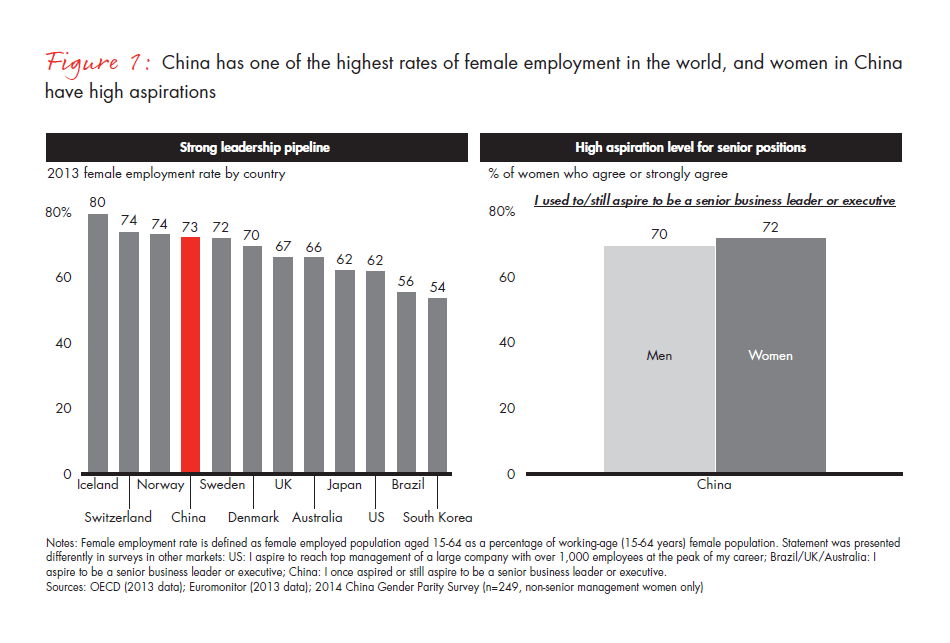
From an organizational perspective, the Chinese work environment appears to be favorable for women. In past research, we’ve looked at the discrepancies between what employees believe an organization should do regarding gender parity and what it actually does. While any discrepancy is disappointing, companies in China perform relatively well: 66% of women believe that “achieving gender parity should be a critical strategic business imperative” for their organizations, and 51% of women believe that “qualified men and women have equal opportunity to be promoted on the same time line to senior management or executive positions” (see Figure 2). This 15 percentage-point gap is much smaller than the 72-point gap seen in Australia and the 27-point gap in the US.
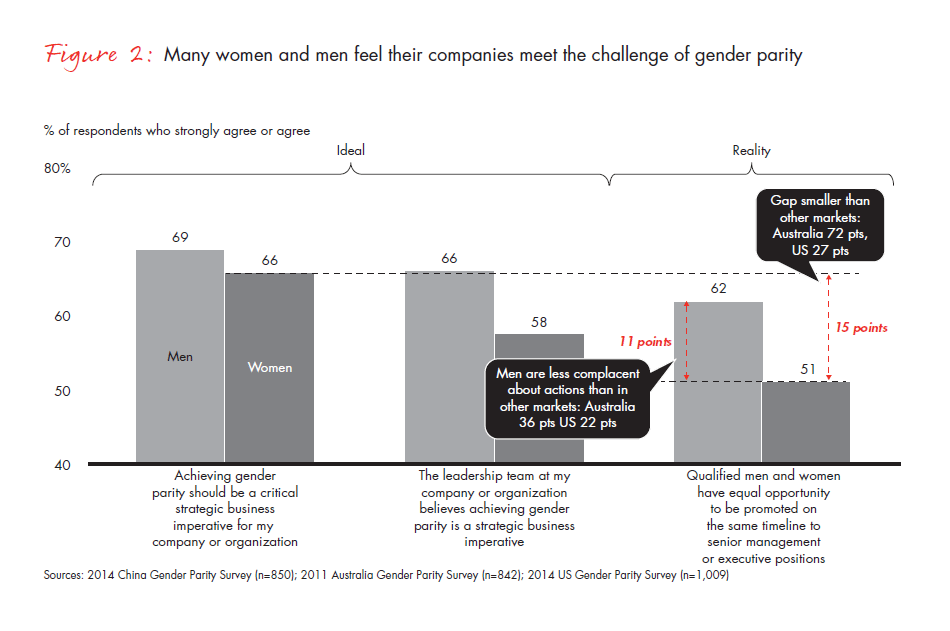
Men in China also appear to have healthy attitudes toward women in the workplace: 69%—a slightly higher percentage than women—agree or strongly agree that achieving gender parity should be a business imperative. And while men in other markets tend to overstate women’s actual opportunities for advancement—often because they are complacent or unaware of barriers—men in China seem to have a fairly accurate view of reality. In fact, 62% believe there is equal opportunity for women, while 51% of women believe the same. This difference is relatively small compared with the 36 percentage-point gap between genders in Australia or the 22-point gap in the US.
This data would suggest that workplaces in China are supportive of women who aim for leadership roles. However, our research reveals that views on women and work are more complex than they might appear. When we ask survey respondents about the workplace environment from other perspectives, it becomes easier to understand why so few women in China progress to management and executive roles (see below, “China’s unique environment for gender parity”).
Using the employee Net Promoter ScoreSM (eNPS) to measure employee engagement (see below, “Employee Net Promoter Score explained”), we find that both men and women believe the professional world is not the best environment for a woman. In response to the core eNPS question—“How likely are you to recommend your workplace to a friend?”—all respondents score significantly lower, on average, when the question specifies a female friend than when the question does not specify gender (see Figure 3).
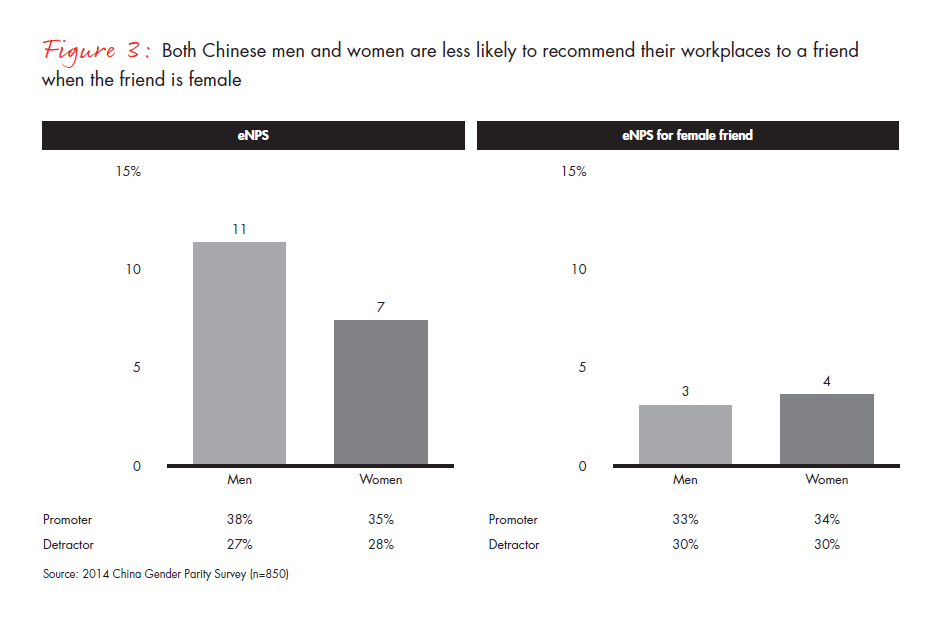
Women’s relatively low advocacy levels for their organizations seem to lead to lower aspiration levels at critical points in their careers. Though they may still be in the workforce, only 8% of junior managers continue to aspire to reach senior management, the lowest aspiration level among all levels of employees below senior management. Given this outlook, many may fail to obtain the necessary experiences and skills that would allow them to progress to the next level, which may explain why women hold only 17% of senior management positions, despite comprising 46% of the professional workforce.
At the structural level, it’s important to note that different types of organizations are at different maturity points in their gender parity programs. Local private companies and multinational corporations are the two types that appear to be taking the strongest action to bring more women into leadership roles. They garnered the highest ratings when the survey asked respondents whether they agreed with such statements as “The leadership team at my company or organization has made gender parity a visible priority” and “My company or organization has committed meaningful resources to implementing gender parity initiatives.”
Taken together, our research reveals both very positive and highly negative aspects to the workplace environment for women in China. To understand exactly where the gaps are, we look at some of the key obstacles that women face in the workplace.
2. Barriers: Three reasons women don’t advance
Based on our survey and in-depth interviews with both executives and experts in the field, we identified three primary barriers to women advancing their careers in China:
- Competing priorities
- Women’s leadership styles are different from men’s, and individuals of both genders are often biased against them
- Organizational biases set women back even further
Competing priorities. To be sure, the stress of juggling work and family commitments is a legitimate reason for the dearth of women in senior roles. This factor influences women in almost all cultures, as they have traditionally stayed home to raise children and manage households while men have not. Surprisingly, despite the fact that childcare is relatively inexpensive in China and grandparents help out, survey respondents indicated that balancing work and personal life affects women in China more than those in other markets. When asked why there were fewer women than men in senior roles, respondents ranked the concept that “Women’s careers are slowed or disrupted by managing both work and family commitments” as the most important factor, whereas globally, it is ranked as only the second-most important factor.
These results, along with our interviews, suggest that many women still feel pressured to be primary caregivers and manage households, regardless of their work status—a perception that men often reinforce. When asked why so few women hold leadership roles, a male human resources executive for a large company said: “Frontline positions are not suitable for women, because women have family commitments and hence cannot focus all their energy on the company.” Furthermore, “Women are physically weaker, so they would not be able to handle the constant travel,” he said, echoing another common theme heard in our research.
The data and attitudes we document suggest it’s not just the practical challenge of balancing work and family that holds women back, but rather some deeply embedded cultural factors that greatly influence behaviors of both genders.
Women’s leadership styles are different from men’s, and both men and women are biased against them. Both men and women are clear that women’s leadership styles are different from men’s, and both perceive them to be weaker. In fact, men in China display a remarkably consistent belief across a multitude of leadership attributes that women are less capable than they are (see Figure 4). While some bias might be expected, this consistency stands in sharp contrast to other markets, such as the US and Brazil, where men acknowledge women’s strengths on about half the relevant leadership attributes. In China, women gained ground on only one attribute—consulting— where men ranked them equal in ability.
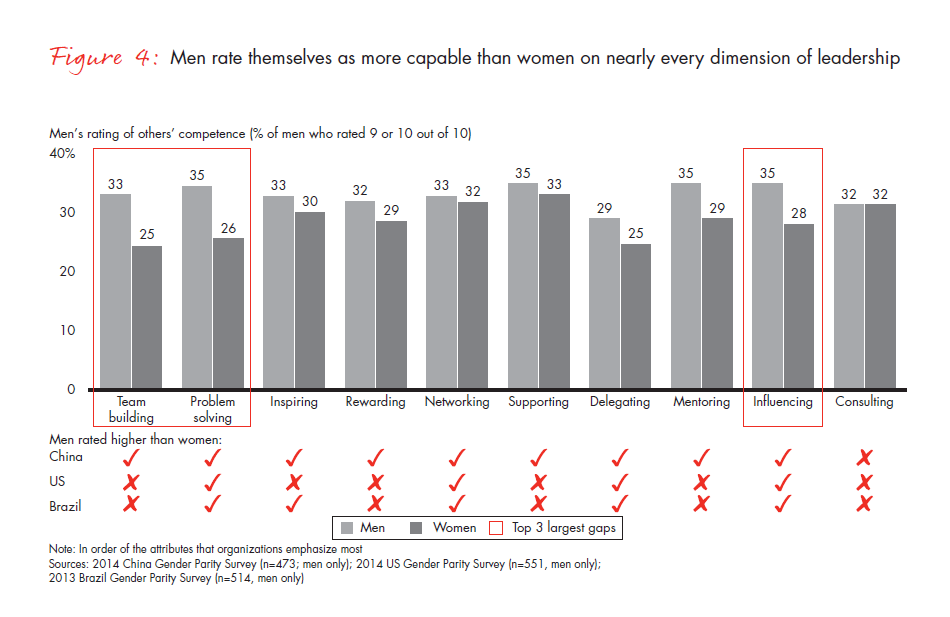
Women appear to have internalized men’s beliefs about their abilities and tend to rate their own leadership skills even lower than men do (see Figure 5). This results in a personal confidence gap, but also affects how they perceive other women: Female respondents universally rate women as being less competent than men on critical management components, such as team building, problem solving and rewarding.
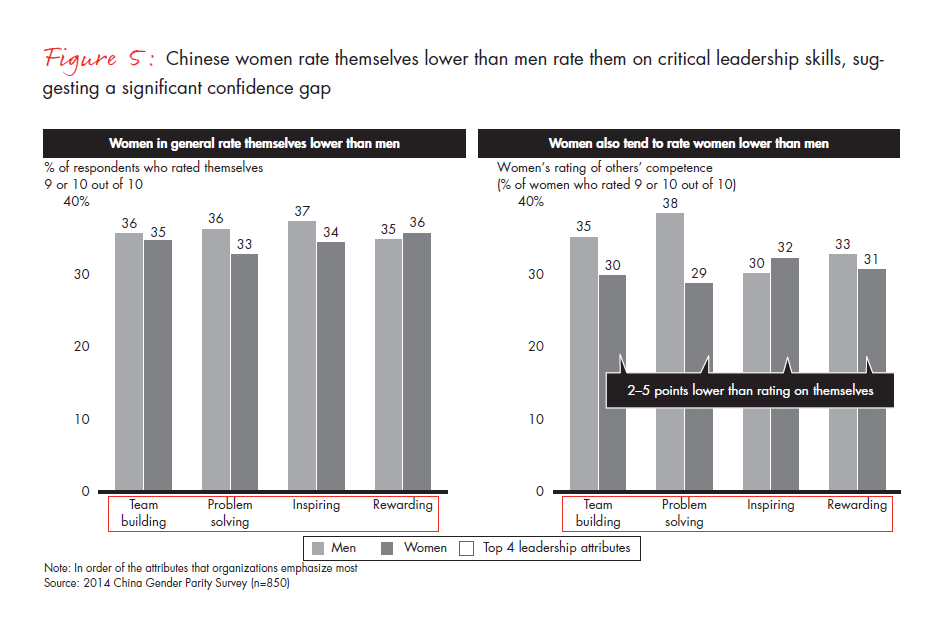
Organizational biases against women push them even further back. At an organizational level, the bias against women continues in a variety of ways and often spurs women to discount their ambitions. For example, more than 60% of men say that women have an equal chance of being recruited, promoted or appointed to management roles or other leadership positions, but just about 50% of women believe they do.
To some extent, men in China validate the difficulties women face in the workplace (see Figure 6). They believe that women are more likely than men to be overlooked for a role due to a perceived lack of flexibility and commitment, or to be paid less than a man in a similar role; however, they still don’t experience the difficulties as significantly as women do.

Despite this awareness of organizational bias, we find that leaders overrate the effectiveness of the gender parity programs that are intended to mitigate the bias. Across all forms of gender parity initiatives—networking groups, flexible work arrangements, flexible or nontraditional career paths, formal mentorship and coaching programs, and formal sponsorship programs—survey results show that senior managers consistently believe these initiatives are used more often and are more effective than junior people believe they are. The perception gap between junior and senior people ranges from 3 to 15 percentage points, with the greatest gaps occurring in response to questions about how women use and benefit from such initiatives. These managers have little motivation to invest more heavily in the programs; most think they are working fine already.
3. Solutions for a better workplace: Actions that employers, families and women can take today
The barriers that women face in the workplace are not insurmountable. Everyone in the workplace has a role to play in helping women escape negative stereotypes. The good news is that many are already moving in this direction and already have offered one or more gender parity programs in place. However, it is clear that the current solutions are not sufficient. Based on survey data and interviews with female executives, we have developed key actions that employers, families and individual women can take to help maximize personal potential, as well as organizational performance.
All three parts of the equation—employer, family and individual—are critical to success (see Figure 7). If companies change policies but women don’t step up to the opportunities, little change is likely. Similarly, if women begin to recognize their own potential but are tied to household commitments, they will not be able to progress.

Actions for forward-thinking organizations
Getting more women in top roles is not just good for women, it’s good for the organization. Our research shows that genuine gender parity efforts tend to increase employee engagement, which often correlates with better business performance. Companies and organizations must revisit the ways they support their female employees and make sure they are getting the maximum benefit for their efforts.
One way to think about gender parity efforts is to separate them into “hardware,” such as policies and programs, and “software,” i.e., how they play out in daily life (see Figure 8). One reason that China has a relatively favorable workplace environment for women may well be the strength of its “hardware.” Government policies support the goal, and many companies offer some form of a gender parity program. Those programs can improve, as we suggest below, but companies may ultimately achieve the greatest degree of transformation by focusing on “software,” or the everyday experiences of employees.
Here, we look at six ways companies can improve their gender parity initiatives.
Hardware
Make sure the gender parity initiatives that are in place are the right ones—and then invest heavily in encouraging employees to use them while monitoring their results. There are many ways to help foster gender parity, and leaders should ensure their efforts are tailored to their organizations. When setting up programs, for example, leaders might take geographic differences into account. Our survey shows that employees in the western region believe setting targets and quotas is most effective, while those in the southern, eastern and central regions rank targets and quotas fairly low among gender parity enablers. Similarly, different regions have different views on the relative importance of training and flexible work arrangements.
Understanding which initiatives employees prioritize is an important first step in determining how to focus gender parity efforts. However, merely setting up a program is not enough. Managers must demonstrate personal commitment and enthusiasm for such initiatives from the top down to get the most out of them. While all gender parity programs have some positive impact on employee engagement, our research shows NPS gains an additional 6 to 13 percentage points when managers fully support and encourage them.
Go beyond good intentions and invest in eliminating biases from key people processes, including recruiting, promotions and compensation decisions. The most valued initiative to close the gap between intention and outcome is ensuring that recruiting/promotions are unbiased and involve a diverse set of decision makers, with about 25% of survey respondents believing it to be one of the top two drivers of genuine gender parity. The perception of equal opportunity benefits both men and women. For example, employees who perceive that men and women get equal remuneration for similar roles have higher NPS—26 points higher for men and 22 points for women—than those who perceive inequality.
Software
Strong commitment from the top. When senior leaders commit meaningful resources to implementing gender parity initiatives, employee NPS increases by 77 points for women and 95 points for men. This dramatic spike in employee engagement is not just good news for gender parity initiatives, it is good news for the organization as a whole.
Strive for female role models in top positions. Neither men nor women seem to like female bosses, who are perceived as being overly detail-oriented to the point of micromanaging. As women move up in seniority, they are also more likely to be labeled “aggressive” and “less feminine.” Such stereotypes and labels can undercut women’s confidence levels and make it more difficult for them work effectively with others. Yet overcoming them is difficult, as stereotypes—rightly or wrongly—tend to be deeply embedded in cultures.
One of the most powerful tools companies have for counteracting these negative labels is to create more positive role models by striving to place and support women in top positions. As employees see women succeeding as leaders, they can replace their old perceptions with new ones. To maximize this strategy, companies might also ask these women to encourage other women coming up in the organization, creating a self-reinforcing source of advocacy. Another benefit of this strategy is that it tends to have a significant domino effect all along the pipeline: Female junior managers who have female role models are nearly three times as likely to aspire to a senior role as those who don’t have role models.
Emphasize the critical role of the frontline supervisor. Commitment from the top is crucial, but so is commitment from the supervisors and managers who interact with employees every day. Companies should empower managers to support women in their daily jobs, and to encourage dialogue and planning around women’s future career aspirations.
Engage men in the mission to create an environment that is welcoming of female leadership. Gender parity issues often become women’s issues, since women ostensibly suffer the most from the lack of parity and have the most to gain from achieving it. Top organizations, however, increasingly realize that men are a critical part of the conversation, as the outcomes affect them—and organizational performance—as well. As the head of strategy for a multinational corporation in China notes: “Men are part of the problem, so they should be part of the solution, too.”
Involving men in gender parity efforts accomplishes several objectives. For one, getting their input on initiatives makes it more likely they will support them. It can also help them recognize and overcome the biases that may permeate their thinking. Finally, by taking on functions such as networking and mentoring, men can help alleviate some of the burdens that face women who become role models, as they are expected to not only succeed in their own careers but also to help many others succeed at the same time.
Actions for supportive spouses and families
Work out ways for both spouses to manage the household (including child care). This action item challenges cultural norms, as men are generally not comfortable with the idea of taking full responsibility for the household. They may be more open to sharing the work, however, if they realize the profound impact it can have on their wives’ careers. In our research we found that the average eNPS of women who had their spouses’ support in managing the household was 27 points higher than it was for those who were primarily responsible for housework. Notably, it was also higher than the eNPS of those who had hired help. Sharing household responsibilities with her spouse would greatly relieve a woman’s burden—actual and perceived—in terms of family commitments, thus allowing her to spend more time developing her career.
Actions for aspiring women
One of the themes that resonated loudly in the survey and in interviews is that women need to plan ahead for career success, rather than expecting it to evolve naturally. That means taking some risks, being more assertive and, often, revising their own assessments of themselves.
Some specific actions:
Develop long-term career plans. Long-term career plans appear to be an imperative for women. Among women who are in board positions, 75% have both long- and short-term career plans, and the rest have at least some short-term plans.
Actively seek out professional support and guidance. Women are frequently reluctant to voice their aspirations and their disappointments—and their careers suffer as a result. Executives are likely to overlook women for promotions because they assume women’s silence means they’re uninterested in promotions. “Women should raise their hands more often and be more vocal about their ambitions,” says one female strategy head at a multinational corporation. “Communicate and let others know what position you’d like to take.”
One of the easiest ways to pursue one’s ambition is to ask others for advice on how to get to a desired role, probing what experiences and knowledge an employee should have to qualify for it. Regular dialogue with direct bosses, as well as mentors, can help foster such professional support.
Another model for bridging the gender gap is the sponsorship model, in which senior leaders meet regularly with junior employees who have high aspirations and then help advocate for them when relevant career opportunities arise. This model has proven to be a helpful catalyst in other markets, including the US, and could be even more effective in a market like China, where women are not accustomed to voicing their goals and frustrations.
Invest in both internal and external networking to find more opportunities. Many job opportunities are never advertised, but rather get filled through a hiring manager’s network of colleagues. Traditionally, men have dominated these networks, in large part because they are expected to form such connections. Women should aim to develop their own peer networks with both male and female colleagues, both inside and outside their organizations.
Similar to voicing ambition, one way to build this type of network is to reach out to peers for advice and then give back by sharing advice with others. Company-sponsored networks can be one platform for such connections, though contacting someone individually is also very effective.
Be confident in yourself and don’t let self-doubt hold you back. How women perceive themselves has a big impact on how others perceive them. If women continue to underrate their skills, men are likely to continue doing so, too. Conversely, if women begin to celebrate their strengths, they may change men’s perceptions of their abilities. One sound piece of advice: “Don’t be so critical of yourself, and don’t constantly strive for perfection,” says the strategy executive.
4. Conclusion
Despite the amount of work that still remains to close the gap between men and women in leadership roles in China, there are many encouraging signs. For one, some industries appear to excel in offering equal opportunities. More than 70% of respondents in the telecom, insurance, professional services (excluding law and accounting) and hospitality management industries perceive that their companies treat qualified men and women equally when it comes to promotions.
Other anecdotes suggest that organizations are making genuine efforts to support and promote women, even during the difficult child-raising years. One woman, now the director of human resources at a global technology company in China, notes that she left work completely to raise her children, but returned to her company four years later, after her sponsor encouraged her.
Our research suggests that the way forward on gender parity in China is to embrace both the negative and positive. Men and women must acknowledge and address the negative bias and stereotypes they may carry with them about women leaders; at the same time, there are plenty of successes that organizations can emulate and build on. While precise strategies toward equality will look different at different organizations, one truth is universal: Getting more women into top roles will have benefits not just for working women, but for working men, business performance and society as a whole.
China’s unique environment for gender parity
China has a strong female leadership pipeline, thanks to the high number of women who work and who aspire to top roles. Compared with women in other countries, women in China are also more likely to believe their companies are living up to their ideals of equality. However, there is one notable obstacle to women advancing: Men in China rate women’s leadership abilities much lower than men in other markets.
- 73% of women in China work vs. 66% in Australia, 67% in the UK and 62% in the US.
- 72% of women working in China have ever aspired to senior leadership vs. 70% of men.
- 66% of women in China believe “achieving gender parity should be a critical strategic business imperative” for their organizations, and 51% of women believe that “qualified men and women have equal opportunity to be promoted on the same time line to senior management or executive positions.” This 15 percentage-point gap is much smaller than the 72-point gap seen in Australia and the 27-point gap that exists in the US.
- 62% of men in China believe there is equal opportunity for women to be promoted—11 percentage points higher than women—but a relatively small difference compared with the 36 percentage-point gap between genders in Australia or the 22-point gap in the US.
- The idea that women’s careers are slowed or disrupted by their family commitments is considered the top obstacle to women advancing in China. Respondents in other countries consider it secondary to men being more inclined to promote others who are like themselves.
- Chinese men rate themselves as being more capable than women on nearly every dimension of leadership, in sharp contrast to the US and Brazil, where men acknowledge women’s strengths with respect to about half the relevant leadership attributes.
Employee Net Promoter Score explained
The employee Net Promoter Score groups respondents into three categories: promoters, passives and detractors.
- Promoters (score of 9 or 10): People who feel their lives have been enriched by their relationships with their organizations or leaders. They are loyal employees, typically stay longer and recommend the organization to their friends and colleagues.
- Passives (score of 7 or 8): People who are fairly satisfied but not loyal employees. They rarely recommend their companies, and when they do it’s likely to be qualified and unenthusiastic. If a better employment offer comes along, they are likely to defect.
- Detractors (score of 0 to 6): People who feel their lives have been diminished by their associations with their organizations or leaders. They are dissatisfied, and even dismayed, by how they are treated. They frequently speak negatively about their organizations and are likely to leave as soon as they find something better.
Jennifer Zeng is a partner at Bain & Company’s Beijing office. Michael Thorneman is a Bain partner in Shanghai, where he heads the firm’s practice in Greater China.